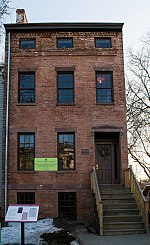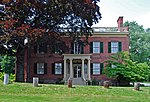The Arbor Hill Historic District–Ten Broeck Triangle, originally the Ten Broeck Historic District, is a seven-block area located within the Arbor Hill neighborhood north of what is today downtown Albany, New York, United States. In 1979 its easternmost third, the Ten Broeck Triangle, the second oldest residential neighborhood in the city, was recognized as a historic district and listed on the National Register of Historic Places. Four years later, the district was increased to its current size and renamed to reflect its expansion to include some of the rest of Arbor Hill.The future district was first established by its oldest contributing property, the Ten Broeck Mansion, built at the end of the 18th century by a prominent local family. It lent its name to the Ten Broeck Triangle, established in the middle of the following century when successful businessmen, primarily lumber dealers, built large houses along Ten Broeck Avenue with the fortunes they had made from trade on the Erie Canal. It was one of the first neighborhoods to develop north of the city's downtown as it grew during the 19th century.
Its fortunes began to slip as the city expanded westward to new neighborhoods like Washington Park which attracted the city's affluent. As the 20th century began, it gradually became a more middle-class neighborhood, then, after the Great Migration, predominantly African American. As an effective racial ghetto, the neighborhood and its historic buildings suffered the effects of disinvestment and decline. The designation of the historic district, and other efforts by preservationists later in the century, have begun to reverse that trend. In the late 2010s Albany mayor Kathy Sheehan and her husband bought and rehabilitated one of the district's vacant townhouses to make their home.
Over 200 buildings, mostly a mix of rowhouses and detached houses built between the 1840s and 1870s, are listed as contributing properties. The largest, the Ten Broeck Mansion, is also the only property in the district listed on the Register individually. The district also includes two churches, including St. Joseph's Church, reflecting a later popularity with immigrants.










